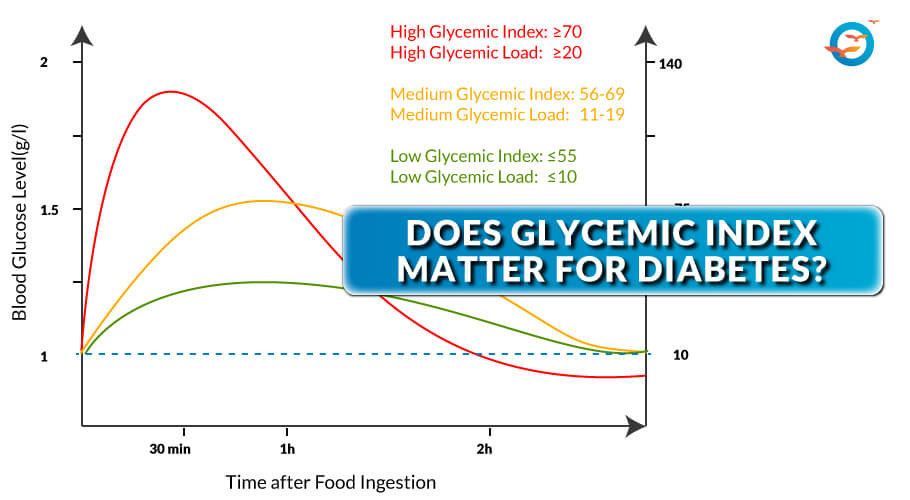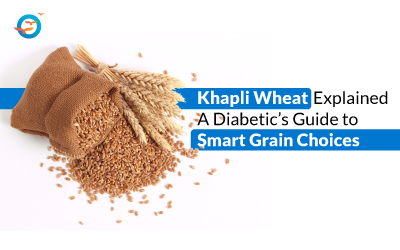What is Glycemic Index (GI)?

Does glycemic index matter for diabetes?
Glycemic index (GI) is simply a measurement of how long and how high a particular food makes your blood sugar level (BSL) rise.
All carbohydrates are not created equal; some are converted into glucose rapidly and enter the bloodstream leading to quick spikes, whereas others work more slowly.
Each food is assigned a value depending on the time it takes for its effects to show in one’s BSL. This is the glycemic index. By checking the assigned GI value of the food, the consumer knows which foods to consume and which to avoid.
The GI index runs from 0 to 100., with pure sugar (glucose) having the highest rating, viz: 100. All other foods are assigned a GI value depending on the time it takes for the body to convert the carbs in that food into glucose.
Only carbohydrate foods have a GI measure. Since meat, fat, and oil have no carbohydrates, they do not have a GI index number. However, they can have a detrimental effect on insulin resistance and diabetes.
What are high and low GI foods?

Foods having a low GI value increase glucose slowly in your blood, whereas foods with a high GI infuse glucose into the blood rapidly. Diabetics need to avoid these foods as much as possible, as they make it difficult to control diabetes.
Sticking to low GI foods gives you better control on blood sugar levels. It also has one other beneficial side effect: it helps in weight loss. So pay attention to the GI of the foods you eat. But don’t ignore the volume of carbohydrates as this has an effect on the total amount of carbs entering the body.
Glycemic Index of Select Foods
What are the best low GI foods?
Foods with Low GI between (0 and 55) Choose these foods—but as mentioned earlier, be careful not to over-indulge either.
- Bulgar, barley
- Pasta, parboiled (converted) rice
- Quinoa
- High-fiber bran cereal
- Oatmeal, steel-cut or rolled
- Carrots, non-starchy vegetables, greens
- Apples, oranges, grapefruit, and many other fruits
- Most nuts, legumes, and beans
- Milk and yogurt
(*although milk and yogurt have a low GI value, they are very high in fat, and a compound known as Insulin-Like Growth Factors and should be avoided. You can read your about IGF and its effect on diabetes here.)
What are medium GI foods?
Foods having a GI rating anywhere between 56 and 69, are considered moderate. Diabetics can consume these, but try not to make a meal of them.
- Pita bread, rye bread
- Couscous
- Brown rice
- Raisins
What are high GI foods?
Foods with a GI value of 70 and above are considered to be high GI and should be avoided as they lead to quick and high spikes in BSL-dangerous for diabetics.
- White bread and bagels
- Many processed cereals
- Most snack foods
- Potatoes
- White rice
- Honey
- Sugar
- Watermelon, pineapple
Why would diabetics pay attention to the glycemic index of foods in planning their diet?

When deciding on what to eat for your meals, try and pick only food items that have a low to medium GI. If you do decide to consume a high GI food, do complement it with a low GI food.
This will have a moderating effect, but be circumspect. Also remember, food combinations—even those in low to mid-GI ranges—can alter the GI values of the meal as a whole. Other aspects to keep in mind are: quantities, and, in the case of fruit, ripeness. The riper the food, the higher its GI value.
- Portion size
While quality scores high points when it comes to GI, size matters too, as bigger portions simply translate into more calories, and more carbs. So even if the food you’re eating has a low GI value, keep a strict eye on the size of your portions.
Processed foods generally have higher GI numbers than their untreated cousins. For instance, fruit juice is much higher than whole fruit, and instant potatoes score a higher GI value than whole baked ones.
- Cooking
How and how long a food is cooked also affects the GI of a food. Al dente pasta, for instance, has a lower GI number than soft pasta. Quick-cooking oats are likewise higher than whole oats or steel-cut oats.
- Fiber and Fat
High-fiber foods are highly desirable as fiber slows the absorption of glucose into the bloodstream. Polished, white rice, for example, has a higher GI than brown varieties.
The fat percentage also slows down the conversion and absorption of glucose into the blood, and this has led to the growing popularity of veto-diets. But remember that fat is generally unhealthy.
These diets are not sustainable and can have a disastrous effect on health, especially for diabetics. At FFD, we strongly proscribe keto diets.
Do you want to know What are Low GI superfoods for diabetes? visit our blog.
In conclusion
The GI index is a valuable tool to assess your food choices and curate the best foods for your health. In general, try to include a variety of healthy foods.
Keep the nutritional value of the entire meal, not just the GI value of individual foods. If you do wish to include some high GI food in your meal, ensure you balance it with low GI foods.
Diabetics need to practice carb-counting, as this helps monitor and measure your intake and maintain optimal weight.
If your diabetes is beyond mere carb counting, you would be well-advised to add a proper fitness routine and stress release mechanisms to your regimen. A sustained routine has been shown to do more than control BSL, it can totally reverse diabetes.
FFD’s own Holistic Transformation Program has seen tremendous success with its diet-exercise-stress release protocols. For more information, please visit our website.
FAQs
What are low GI foods?
Low GI foods have a value between 0 and 55 and release glucose slowly, making them ideal for diabetics.
What are high GI foods to avoid?
High GI foods (70 or above) raise blood sugar quickly and should be avoided. These include white bread, potatoes, and sugary foods.
Does portion size matter when considering GI?
Yes, portion size affects the total carb intake, so it's important to monitor both GI and portion size for effective diabetes management.

